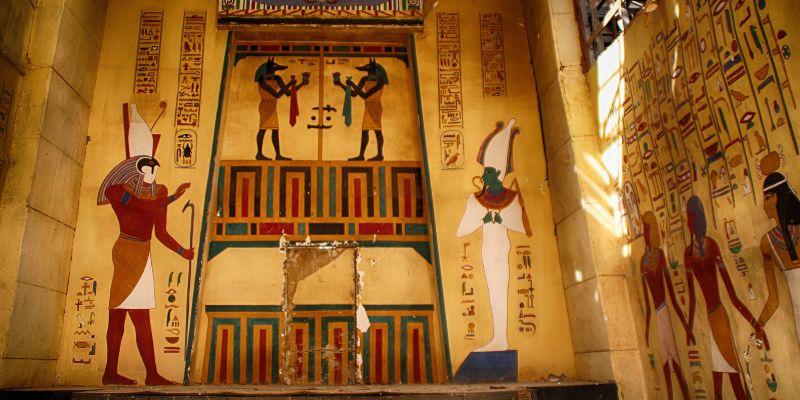Introduction to Ancient Artz
Step into a world where creativity knows no bounds and culture breathes life into stone. Ancient artz, with their intricate designs and profound stories, offer us a glimpse into the minds of our ancestors. These masterpieces are not just relics; they are windows to the past that reveal how civilizations understood beauty, spirituality, and their place in the universe.
Imagine wandering through ancient temples adorned with vivid frescoes or standing before gigantic statues carved out of mountainsides. Each piece tells a story steeped in tradition and history. From the opulent mosaics of Rome to the sacred carvings in Egyptian tombs, ancient artz captivate our senses while inviting us to delve deeper into human expression.
As we embark on this journey through time and culture, let’s explore what makes ancient artz so significant today. How do these artistic legacies influence modern society? Why is it crucial for us to preserve them? Join me as we navigate this fascinating realm where artistry meets heritage—a place where every brushstroke resonates with echoes from ages long gone.
The Influence of Ancient Artz on Modern Culture
Ancient artz have left an indelible mark on contemporary culture, shaping various forms of expression. From architecture to fashion, the echoes of ancient civilizations can be seen everywhere.
Take Greek columns, for example. Their influence is prominent in modern buildings and public spaces. The elegance and strength they convey continue to inspire architects today.
In literature and film, themes from ancient myths resonate with audiences. Stories about gods, heroes, and epic quests still captivate our imagination.
Fashion also draws heavily from ancient aesthetics. Designers often incorporate motifs inspired by textiles and patterns found in historical artifacts.
Even social movements find roots in the philosophies of ancient cultures. Ideas about democracy from Greece or justice from Rome remain relevant as societies evolve.
These connections remind us that our present is intertwined with the past. Ancient artz serve as a bridge between different eras, enriching modern life with their timeless narratives.
The Importance of Preserving Ancient Artz
Preserving ancient artz is crucial for understanding our shared history. These artifacts tell stories of civilizations long gone, reflecting their beliefs, values, and creativity. When we protect them, we safeguard a window into the past.
Each piece holds immense cultural significance. They connect us to generations that came before us and provide insight into human evolution. This connection helps foster appreciation for diverse cultures around the world.
Additionally, ancient artz serves as an educational resource. Students and researchers benefit from studying these works in context. They inspire new generations of artists and historians alike.
Environmental factors also threaten these treasures. Climate change, pollution, and urban development pose significant risks. Active preservation efforts can mitigate damage while ensuring future access to this invaluable heritage.
As stewards of culture, it’s essential to advocate for better protection measures globally. By doing so, we honor the legacy left by our ancestors while enriching our own lives through their creations.
Top Ancient Artz Destinations Around the World
When it comes to exploring ancient artz, some destinations stand out for their breathtaking works and rich histories.
The Pyramids of Giza in Egypt draw millions each year. These colossal structures tell stories of pharaohs and the afterlife through intricate carvings.
In Greece, the Acropolis showcases stunning sculptures that celebrate gods and mythology. The Parthenon remains a testament to classical beauty.
Traveling to Mexico, one can marvel at the vibrant murals of Teotihuacan. They reflect cultural narratives woven into every brushstroke.
Onward to Peru, Machu Picchu offers not only breathtaking views but also architectural wonders steeped in Incan artistry.
A visit to Angkor Wat in Cambodia reveals an entire world carved from stone dedicated to Hindu deities. Each temple holds secrets waiting to be uncovered by curious travelers.
These sites are more than just tourist attractions; they are gateways into our collective past filled with creativity and innovation.
Uncovering Hidden Gems: Lesser-Known Ancient Artz Sites
While many flock to iconic sites like the Pyramids of Giza or Machu Picchu, countless lesser-known ancient artz locations hold their own enchanting stories. These hidden gems often reveal unique cultural insights.
Take Timgad in Algeria, for instance. This Roman colonial town features stunningly preserved ruins that transport visitors back to ancient times. The intricate mosaics and grand archways whisper tales of a vibrant past.
Venturing deeper into Turkey uncovers the rock-carved churches of Cappadocia. Here, frescoes narrate Christian history amid surreal landscapes formed by volcanic eruptions.
Similarly, the ancient city of Hampi in India boasts remarkable stone temples and boulder-strewn vistas that echo its regal history as part of the Vijayanagara Empire.
Exploring these off-the-beaten-path destinations allows travelers to connect with diverse cultures while appreciating artistry that has stood the test of time. Each site beckons us to explore further and discover untold narratives woven into our shared human heritage.
The Impact of Technology on the Study and Preservation of Ancient Artz
Technology has revolutionized the way we study and preserve ancient artz. Advanced imaging techniques, like 3D scanning and digital modeling, allow researchers to explore intricate details that were once invisible. This not only enhances our understanding but also aids in restoration efforts.
Virtual reality brings ancient sites to life. Instead of visiting physically, people can immerse themselves in historical landscapes from their homes. This democratizes access to culture and education.
Moreover, data analytics helps track the condition of artifacts over time. Sensors monitor environmental changes that might affect preservation. By utilizing such tools, experts can make informed decisions about conservation strategies.
Collaboration across borders is easier now than ever before thanks to technology. Scholars share findings instantly with global networks. This collective knowledge fuels innovative approaches to protect our shared heritage for generations ahead.
Conclusion: Why We Should Continue to Appreciate and Learn from Ancient Artz
The legacy of ancient artz is woven into the fabric of our cultural identity. These remarkable works offer a window into the minds and hearts of those who came before us. They tell stories, convey emotions, and reflect societal values that have shaped civilizations over millennia.
As we navigate an increasingly modern world, it’s crucial to keep these historical treasures alive in our collective memory. Engaging with ancient artz fosters a deeper understanding of humanity’s shared experiences. It sparks conversations about creativity, innovation, and resilience through time.
Furthermore, appreciating ancient artz enriches our lives today. It inspires contemporary artists while reminding us of the beauty and complexity inherent in different cultures. Our commitment to preserving these artifacts ensures future generations can also learn from them.
There’s much more than mere aesthetics at play when we explore ancient artz; there are lessons about survival, expression, and community that resonate even now. Embracing this journey allows us to honor past achievements while inspiring new ideas for tomorrow’s creators.
Let’s continue exploring this fascinating realm together—because every piece has a story worth telling and a history deserving recognition.







